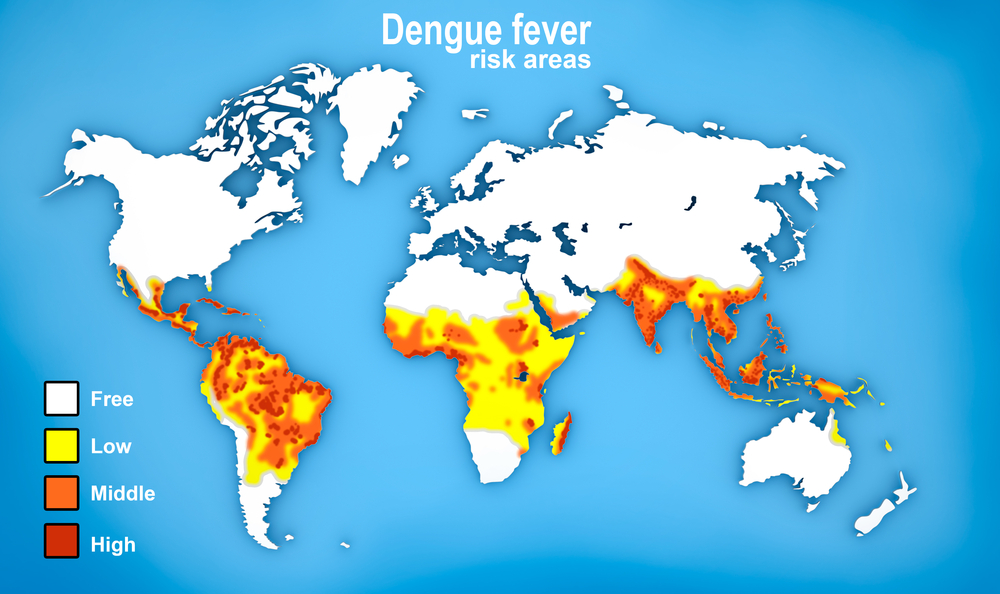Table of Content
ToggleIntroduction
Dengue fever, a mosquito-borne viral illness, affects millions of people worldwide each year. Caused by the dengue virus, this disease has become a significant global health concern, with over 100 countries in Africa, America, and Asia experiencing endemic outbreaks. Although the virus exists in two forms – Dengue Fever and Dengue Haemorrhagic Fever – both can result in severe, even life-threatening, complications for those infected.
Transmission of the virus occurs primarily through the bite of female Aedes mosquitoes, which serve as vectors for the disease. Early symptoms of dengue can include high fever, severe headache, joint and muscle pain, and rash. As the infection progresses, more serious symptoms may develop, such as persistent vomiting, difficulty breathing, and signs of bleeding. Diagnosis typically involves laboratory tests, and treatment focuses on relieving symptoms and managing complications.
Key Takeaways
- Dengue fever, caused by the dengue virus, is an increasingly prevalent mosquito-borne illness affecting millions worldwide.
- Symptoms of dengue range from fever and pain to more severe manifestations like difficulty breathing and bleeding.
- Diagnosis relies on lab tests, while treatment aims to alleviate symptoms and prevent complications.
Symptoms of Dengue
Physical Symptoms
Dengue fever typically begins with a sudden onset of high fever, which lasts for about 2-7 days. During this time, patients may experience a range of physical symptoms, including severe headache, muscle pain, and pain behind the eyes. Additional symptoms can include skin rash, nausea, and vomiting.
The fever is often accompanied by other flu-like symptoms such as aches, joint pain, and general weakness. The severity of these symptoms may differ from person to person and can worsen the overall health of the infected individual.
Warning Signs
While most cases of dengue fever are mild, it is crucial to monitor for specific warning signs that could indicate a more severe form of the infection, known as dengue hemorrhagic fever. These signs may include:
- Persistent vomiting
- Severe abdominal pain
- Rapid breathing
- Bleeding gums
- Fatigue or restlessness
- Blood in vomit
If these warning signs occur, the individual should seek medical attention immediately to prevent serious complications.
In summary, the symptoms of dengue fever can range from mild to severe and should be monitored closely for warning signs indicating a more critical infection.
Symptoms of Dengue
Physical Symptoms
Dengue fever is characterized by a sudden onset of high fever, often accompanied by headache, muscle and joint pain, and a rash. The fever typically begins with a temperature of around 104°F (40°C) and may last up to 7 days. Patients may exhibit pain behind the eyes, nausea, and vomiting. The skin rash typically appears 3-4 days after the onset of fever and may spread from the torso to the limbs and face.
- High Fever: A fever of 104°F (40°C) or higher
- Headache: Often severe
- Muscle and Joint Pain: Also known as myalgia and arthralgia
- Skin Rash: Appearing 3-4 days after fever onset
Warning Signs
During the course of the illness, some patients may develop warning signs that signal a progression to more severe forms of dengue, such as dengue hemorrhagic fever or dengue shock syndrome. These signs include severe abdominal pain, persistent vomiting, rapid breathing, fluid accumulation, mucosal bleeding, and a drop in platelet count. It is crucial to monitor for these signs and seek prompt medical attention if they occur.
Causes of Dengue
Transmission
Dengue fever is caused by the dengue virus, which is transmitted to humans through the bite of an infected Aedes mosquito. There are four distinct serotypes of the virus, namely DENV-1, DENV-2, DENV-3, and DENV-4. Infection with one serotype provides lifelong immunity to that specific serotype but not to the others. Subsequent infections with other serotypes can result in severe cases of the disease, such as dengue hemorrhagic fever.
Vectors
Aedes aegypti and Aedes albopictus are the primary mosquito species responsible for the transmission of the dengue virus. These mosquitoes are daytime feeders, with peak feeding activity in the early morning and late afternoon. They predominantly breed in stagnant clean water and are found in both urban and semi-urban environments.
| Aedes Species | Breeding Site | Feeding Time |
|---|---|---|
| Aedes aegypti | Stagnant clean water, urban areas | Daytime (morning, late afternoon) |
| Aedes albopictus | Stagnant clean water, semi-urban areas | Daytime (morning, late afternoon) |
The female Aedes mosquitoes acquire the virus while feeding on the blood of an infected human host. Once infected, the mosquito becomes a vector and can transmit the virus to other humans during subsequent blood meals. Effective mosquito control measures and public awareness are crucial to reducing the spread of dengue fever.
The risk of transmission is heightened during the rainy season as mosquitoes proliferate and breed in standing water. It is essential to monitor and control the presence of Aedes mosquitoes in order to prevent the spread of the dengue virus.
Disease Progression
Initial Infection
Dengue fever is caused by the dengue virus, which is transmitted to humans primarily through the bites of infected Aedes mosquitoes. In the majority of cases, initial dengue infection results in mild symptoms, often resembling the flu, including fever, headache, and muscle pain. Some patients may develop a characteristic rash as well1.
In cases where a more severe form of dengue fever occurs, the disease progresses through three phases: febrile, critical, and recovery2. The febrile phase typically lasts 2-7 days and is marked by a high fever and other flu-like symptoms. It is not always possible to predict whether an individual will progress to the more severe forms of the disease during the febrile phase.
Severe Dengue
Severe dengue, which includes dengue hemorrhagic fever (DHF) and dengue shock syndrome (DSS), is characterized by an increased risk of complications such as internal bleeding, shock, and organ failure3. These complications occur during the critical phase, which takes place after the febrile phase and usually lasts for 24-48 hours2. Warning signs of severe dengue include persistent vomiting, abdominal pain, rapid breathing, and bleeding gums4.
Dengue hemorrhagic fever involves spontaneous bleeding, low platelet counts, and increased vascular permeability. This can lead to plasma leakage and the development of DSS. Dengue shock syndrome is characterized by a rapid and weak pulse, narrowing pulse pressure, and eventual circulatory collapse3.
Prompt medical intervention is crucial for the successful management of severe dengue complications. Treatment largely involves supportive care, including fluid replacement therapy, blood transfusions, and monitoring of vital signs2.
Footnotes
Diagnostic Tests
Dengue fever is a mosquito-borne viral infection that can lead to severe flu-like symptoms. Early detection and diagnosis are essential for proper patient management and control of the disease. There are several diagnostic tests available for dengue fever, which primarily focus on detecting the presence of dengue virus or its specific antibodies in the blood samples of patients.
ELISA (enzyme-linked immunosorbent assay) is a widely used technique to detect the presence of dengue virus non-structural protein, NS1, and IgM/IgG antibodies in the blood samples. The multicountry prospective clinical evaluation of two ELISA tests, the SD Bioline Dengue Duo and the Panbio Dengue Early Rapid, indicated good diagnostic accuracy for diagnosing dengue fever.
In recent years, rapid diagnostic tests (RDTs) have gained popularity for their ability to provide point-of-care diagnosis. These tests are quick, simple, and relatively inexpensive. A study discussed the potential of commercial dengue RDTs for diagnosing acute dengue virus infection, emphasizing the need for more evaluations to determine their effectiveness in different settings.
Some researchers have also explored the development of new nanodiagnostic tools for dengue, although, as of now, they have not resulted in any commercially available test kits. The microfluidic system for dengue detection, however, has shown promise in the literature.
It is crucial to keep in mind that the characteristics of an ‘ideal’ dengue diagnostic test depend on the purpose it will serve, whether for clinical or public health applications. Furthermore, proper interpretation of test results is critical, as false positives or negatives can have severe implications for patient care and disease control efforts.
In summary, diagnostic tests play a significant role in the early detection and management of dengue fever. Both ELISA tests and rapid diagnostic tests offer value in different aspects, while advancements in nanodiagnostic tools offer potential for future improvements in dengue diagnosis.
Treatments and Management
Medical Care
In the treatment of Dengue Fever, there is currently no specific antiviral medication available. The primary approach to dealing with dengue infection is symptomatic and supportive treatment. When seeking medical care, doctors will commonly recommend the use of acetaminophen or paracetamol to help reduce fever and alleviate pain. It’s essential to avoid aspirin or other nonsteroidal anti-inflammatory drugs (NSAIDs) as they can increase the risk of bleeding complications.
Patients experiencing severe cases of Dengue Fever might require more intensive medical care. This can include:
- Intravenous (IV) fluid therapy to prevent dehydration and maintain the balance of electrolytes
- Blood transfusions in cases of severe bleeding
- Oxygen therapy for those with difficulty breathing
Home Care
While receiving medical care, it’s equally crucial to follow appropriate home care measures to aid in recovery. Some home care recommendations for Dengue Fever patients are:
- Rest: Ensure ample rest to help the body recover from the infection and its symptoms.
- Fluid intake: Drink plenty of fluids such as water, fruit juices, and oral rehydration solutions to stay hydrated and replace fluids lost due to fever and sweating.
- Pain relievers: Use acetaminophen or paracetamol as prescribed by the medical professional to manage fever and pain.
| Key Home Care Measures | Details |
|---|---|
| Rest | Aid recovery |
| Fluid intake | Stay hydrated |
| Pain relievers | Manage fever and pain |
Patients must seek medical attention if their symptoms worsen or if they display any warning signs such as severe abdominal pain, persistent vomiting, or difficulty breathing. Early intervention and close monitoring are crucial to ensure a successful recovery and reduce potential complications.













One Response